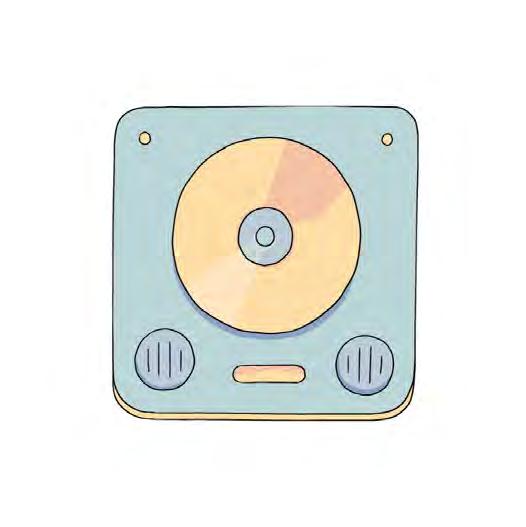TO FAST NO SAY FASHION





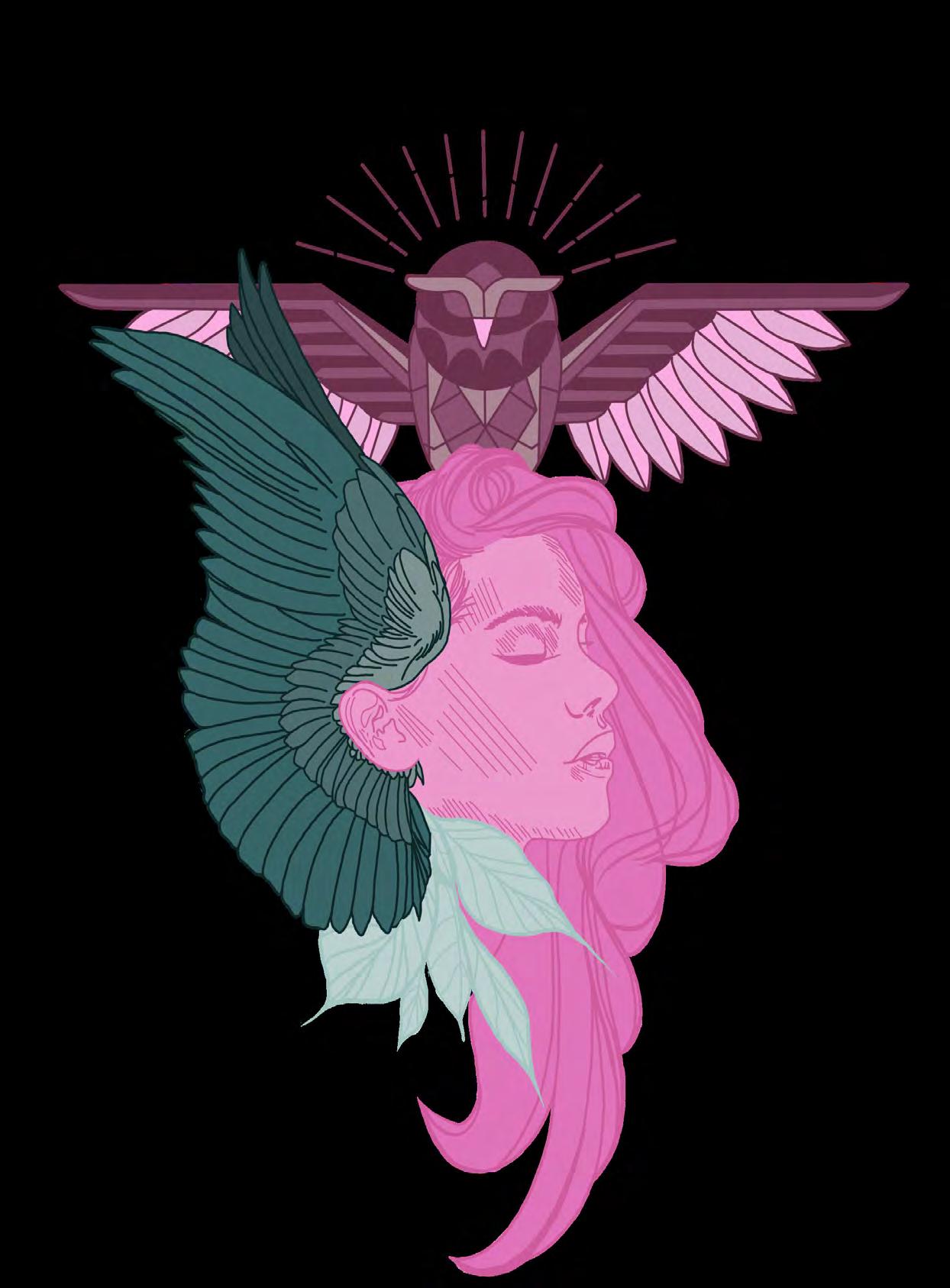
We’re sitting around a table, typing away on our computers, putting the final touches to our first edition of Athena. There’s a scrumptious collection of snacks in the middle of the table, ready to calm our nerves. New beginnings can be daunting, but for the team at Athena, we’re all full of excitement and anticipation. For five weeks, everyone on the team has been writing, designing, and creating content for the launch of our magazine.
Athena is all about encouraging women to be true to themselves, we made sure to include a little bit of something that would interest everyone. From fashion and beauty to music and books, we have it all!
On p25 we have an exclusive interview from the founder of Sustainable fashion week, Bridgett Artise, about how we can express our passion for fashion by being mindful about the environment. Check out p16 if you’re a Harry Styles fan, p10 for some TikTok beauty trends, p38 for an interview with award winning author Laurie Petrou and p30 for Sex therapist Miranda Christopher’s tips on the importance of loving yourself. We also spoke to Molly Mathews about her experience growing up with psoriasis and how she’s learned to feel confident in her own skin, p20. We hope you enjoy reading Athena as much as we enjoyed creating it, and we’d love to hear from you. Get in touch on our Instagram @Athenamag_, happy reading!

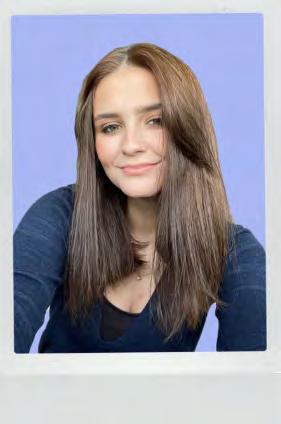
Loves: Summer, Eating Out & Tv Series
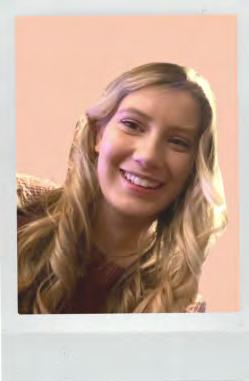
Loves: Coffee, H&M & Italian Food
Loves: Harry Styles, Plants & Books
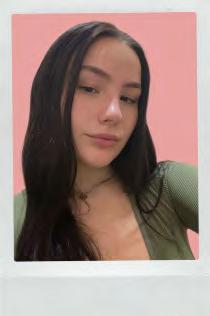
Loves: Tea, Music & Animals
Loves: Fashion, Beauty & Travel
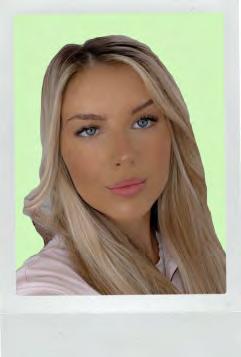
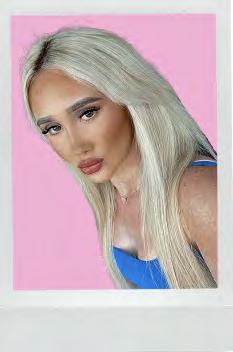
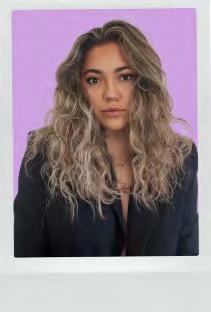
Loves: Music, Art & Formula One
Loves: Gaming, Tennis & Music

Lifestyle
Lifestyle

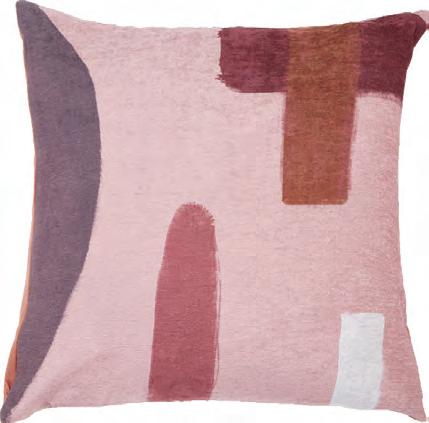
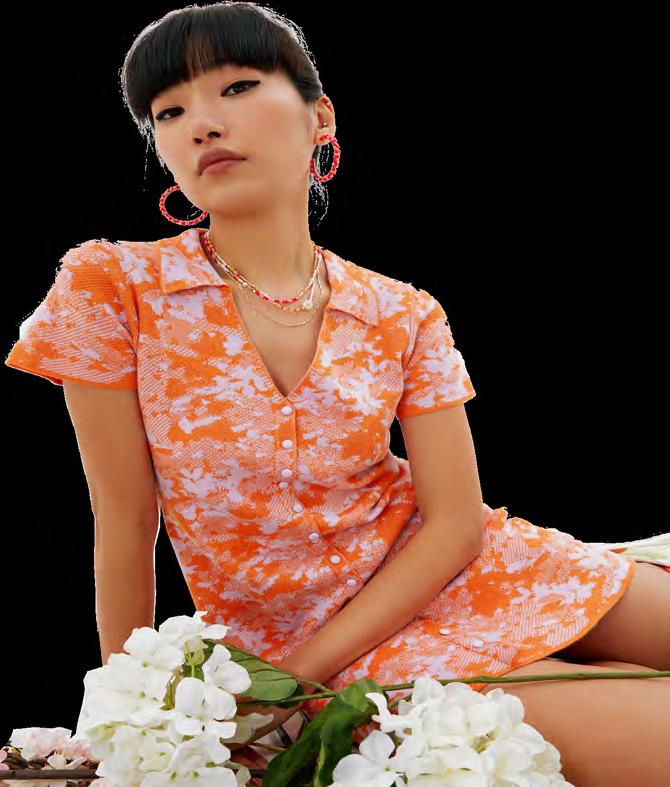
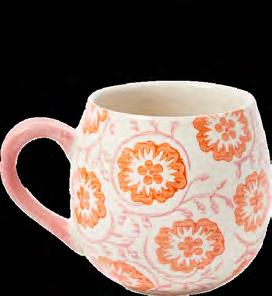
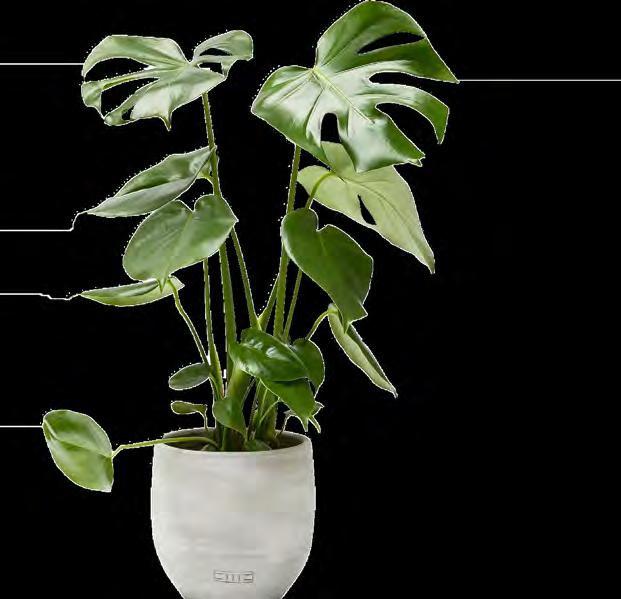
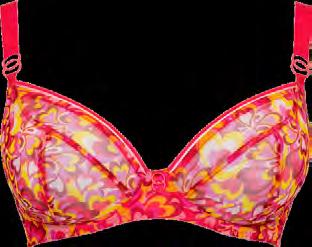
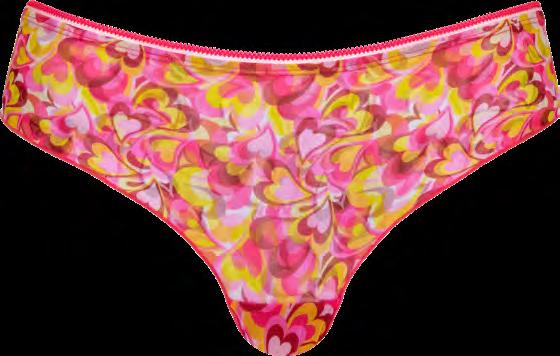



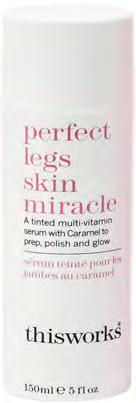

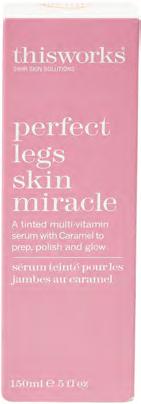
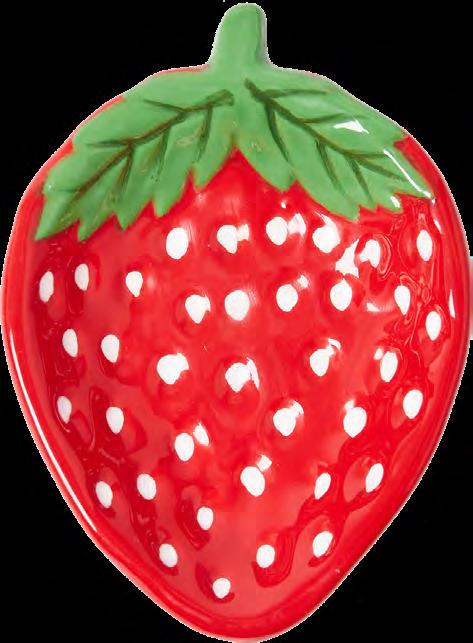 thisworks, £39 Perfect legs skin miracle
Glossier, £12 Boy Brow
Oliver Bonas, £65 Orange Dapple Jacquard Knit Mini Dress
The Little Botanical, £33 Monstera plant, John Lewis
Oliver Bonas, £14 Lila Ceramic Mug
Homesense, £12.99 Pinky brown square cushion
Curvy Kate set, £47
plunge bra pink hearts
short pink hearts
Glossier, £11 Balm dot com
Oliver Bonas, £6.50 Strawberry ring dish
thisworks, £39 Perfect legs skin miracle
Glossier, £12 Boy Brow
Oliver Bonas, £65 Orange Dapple Jacquard Knit Mini Dress
The Little Botanical, £33 Monstera plant, John Lewis
Oliver Bonas, £14 Lila Ceramic Mug
Homesense, £12.99 Pinky brown square cushion
Curvy Kate set, £47
plunge bra pink hearts
short pink hearts
Glossier, £11 Balm dot com
Oliver Bonas, £6.50 Strawberry ring dish

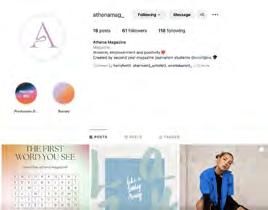

Tik-Tok is now the go-to for many makeup lovers, for finding the latest beauty hacks to watching the craziest makeup transformations. But how do these ‘trends’ compare to doing your everyday makeup routine? Athena Writer Lucy Swift tests them out...
To be completely honest, even though this hack looks beautiful on many influencer’s skin, I was really not looking forward to mixing my £43 ABH foundation into tap water. It felt disgusting on my skin and oh my goodness the separation! The makeup was separating which it has never done before. Yeah it looked natural after a while, but that’s probably because all the water had diluted it into nothing...
I usually put my blush at the sides of my face and on my nose, but I was worried about doing this in one continued brush stroke and having blush under my eyes! I used the Too Faced heart blush as it is my favourite, and I think it turned out really pretty. It didnt look that much different to my usual application and gives a sunkissed-glow, so I can see why this is one of the favourite tik-tok makeup trends.
I do use the ‘lifting’ technique around my eyes in my everyday makeup routine, so i was excited to try it for my whole face. I don’t like much concealer normally as it can feel too thick for my skin, however i did think my face looked more lifted and it didnt feel any different! I used the Too Faced liquid concealer for this step, and I think i might try it again!
The P Louise pink liquid liner was the obvious choice for this one, I love a bit of pink on my eyes. I wasn’t completely sold on this idea, because you still have to figure out where exactly to put the packaging and what sort of angle to hold it at, right? To my suprise, this was so easy and I will certainly be considering this hack again in the future when i fancy a pop of pink on my eyelids!
I wasn’t particularly looking forward to this one, as it’s using so much contour, again it can feel heavy and look thick. I used the Clinique contour stick for this, and I was shocked to see that I really liked the effect! I will definitely be trying this way of applicating contour again, but maybe just for when I’m going out-out.
Again, I wasn’t convinced this tip was going to work wonders, but I got my trusty Charlotte Tilbury lip liner out and gave it a go. I guess it made my lips look fuller and it did have a nice ombre effect when I added some lipstick, but I can achieve the same look without having such an obvious over-line on my top lip. I think I’ll give this one a pass next time...
1.Be consistent in the mornings. Set your alarm for the same time everyday and get up as soon as it goes off!
2.Invest in yourself. Buying new products to enhance your skincare and well-being is a worthwhile purchase and will have you glowing inside and out.
3.Consider researching into nutrition and supplements. Remember, healthy body, healthy mind!
4.Know your personal signs of stress and exhaustion. Your body knows when it needs time to rest, remember to listen to it.
5. Add a treat into your week. Scheduling in a massage or manicure allows you to have something to look forward to and keeps you feeling positive!
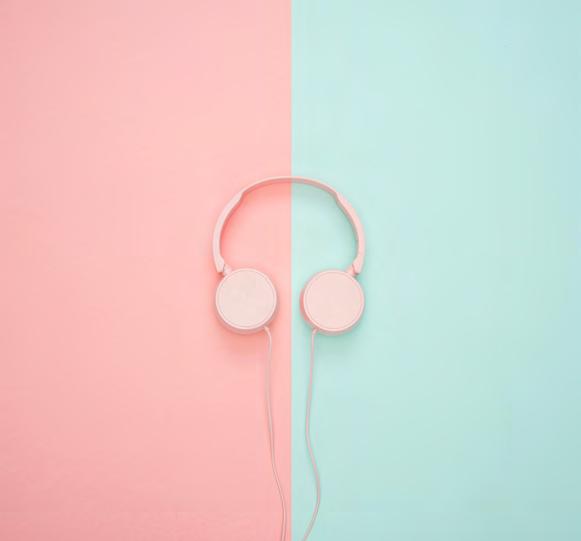


Have you ever wondered which Sex Education character you are most like? You can find out right now! Follow these simple questions to find the answer. Will you be Otis, Eric, Maeve or... one of the other members?
impulSive or planner?
meSSage or phonecall?
maeve wiley
cycle or walk?
SarcaStic or Sincere?
galaxy, lindt or dairy milk?
read a book or watch a movie? Speak your mind or wait your turn?
gibbS
dogS or catS?
Otis is a smart, kind and caring teenager. He is a sweet, introverted, anxious and socially awkward person who sticks up for everyone who he cares about. As shown when he goes above and beyond in his attempts to care for others.
Eric is a loud, fun and bright personality but he is a loyal friend and a great person to have around. He is also up for having a good time! Although, as much as he wants to fit in, he does not care what people think of him.
Maeve is a highly intelligent teenager with a bold and sarcastic personality who generally keeps to herself. Described by Otis as a pessimist with “gems of nihilistic wisdom”, she possesses a morbid sense of humor, often mocking and insulting her peers a lot of the time.
She is one of the school’s ‘popular girls’ but who has an unlikely friendship with Maeve. She is always in a relationship and is way nicer in comparison to other members of the school’s “The Untouchables” clique. Although sometimes she lacks certain knowledge, she has a kind heart.
Jean Milburn is a kind and caring person who sometimes, puts her foot in it during difficult conversations with her son. She loves to provide advice to support people which is fitting for her job as a sex and relationship therapist. She loves to help others with their problems.
Adam is a severely insecure and confused man. He is in a constant search to find himself which sometimes results in unnessesarily making fun of the people around him. He does have a kind heart though and, once he has admitted his true feelings to himself, is a nice guy.
otiS milburn eric effiong maeve wiley Jean milburn aimee gibbS adam groffHarry styles is well known for His extravagant and eccentric fasHion. by His fans, it is loved but, not everybody sHares tHe same opinion. wHo better to talk to tHan a young Harry obsessed teen and an elderly lady wHo Has maybe listened to one Harry song witHout knowing? i spoke to stepHanie and aleksandra about tHese five iconic Harry outfits.
Harry Styles. One of the biggest, if not the biggest, male solo artists of this time. He has displayed his talents as a singer, songwriter, actor and general heartthrob, who has collected an astounding 87 awards alongside 136 nominations. Pretty impressive, considering he has only had three solo album releases. Quite possibly one of the main drawing points towards the star, is his vast and extravagantly wonderful wardrobe. From dresses to feather boas to pearl necklaces, Harry is well known for his iconic sense of style. This style is not always loved by everyone, especially the older generation. I spoke to both Stephanie, a teen who loves Harry Styles, and Aleksandra, an 80-year-old who has maybe listened to Watermelon Sugar once, to find out what each generation thinks about these five iconic Harry outfits.
To the 2021 Grammy awards ceremony, Harry wore a Gucci outfit set with a yellow and black chequered suit jacket with a v-neck pink jumper vest underneath, a pair of brown velvet trousers, a tonne of large rings and, just to top it off, a purple feather boa. Whilst walking around the more crowded areas, he had a yellow mask to match his suit. How cute!
Talking to Stephanie first, who is obviously a massive Harry fan, “I love the feather boa. I think it’s so cool” she then takes a pause, “although, I don’t think that there is too much colour co-ordination going on there and it kinda just looks like it’s been slapped together” she holds up her hands and says “I’m sure it’s not though” and adding, “I especially love all of the rings”.
This being the first outfit that Aleksandra has seen of Harry’s, it takes her a seconds to register. She takes a long pause and stares at the screen. Then proceeds to say, “I like the jacket. I think it’s really nice… not with a purple boa though” and as she peers at the image further adds “I definitely wouldn’t wear all of that together”. To be honest, I’m not sure who else would.
For the Brit Awards 2020, the star put together an outfit that is so simple yet, so effective. This is quite possibly my favourite Harry outfit… EVER! The main asset to it is a gorgeously tailored burgundy suit which is pieced with a purple knitted jumper, a blue shirt with a large white collar, a pair of black shoes with white socks on show, his typical combination of large rings and A LARGE WHITE PEARL NECKLACE!!! He looks so sophisticated and chic whilst still using his favourite larger accessories.
Agreeing with me, Stephanie exclaims “I REALLY love this one” and she smiles “the pearls look cute and… I just really like this one”. As she laughs, she adds “I like the different shades of purple and, I like both the feminine and masculine aspects all in one outfit”. I couldn’t have said it better myself!
Looking closer at the screen so that she can see the outfit details and, as she sits in front of me with a set of pearl earrings on, Aleksandra says, “I like necklaces full stop. I love pearls too. I think that looks really nice” and I smile. She is uncertain in all of the items together but says “I like this one more then the last one because I think the colours go together a bit better”.
When, in November 2020, Vogue released an issue with Harry Styles stood in the middle of a piece of grass, wearing a large dress on the cover, the world went crazy for it. Designed by Gucci, the outfit consisted of two pieces. A black jacket and a light blue dress. Not just any blue dress though, a layered, draped, large, extravagant blue dress with, black fringing and a train behind. What… a… moment!
As you can imagine, Aleksandra takes a sigh. She has loved all of the outfits so far but she is not too sure about this one, “I can’t say that I am falling in love with that one… the dress is alright but, it’s nothing special and, I don’t love the black jacket with it either”.
Stephanie says nothing but “THE iconic dress… oh my gosh”. She takes another second and, continues “I just love the challenging gender ‘norms’. I do really like the dress and, I like that the stereotypical masculine jacket contrasts with the blue dress”. Honestly, this girl, what a legend!
The Grammy’s 2023. OH MY GOSH… what an outfit. What an iconic outfit! Not only did he pick up two Grammy’s along the way but, he also worked the red carpet to the maximum. Made using hundreds of Swarovski crystals, Harry wore a multicoloured, chequered dungarees but, not just any dungarees, a lowcut, shining dungarees. Paired with white shoes and a few rings, the outfit looked simply dazzling.
Aleksandra starts with, “you know, I actually quite like it. I’m not sure about the top part though. It’s a wee bit peculiar” she takes another pause “but I do really love the colour”. Smiling now, “I might wear it to a fancy dress party”.
For this one, Stephanie agrees, “I think that the jumpsuit is interesting” she says with a inquisitive tone but, she adds that she loves that “you can see his tattoos underneath. I think that’s so edgy and cool”. Talking about the design itself, “I like the shimmery pattern, I think it’s really nice”.
Coachella is arguably THE festival to dress up for and, as per usual, Harry did not disappoint. During day two of the event, the singer performed onstage wearing an all-pink outfit courtesy of Gucci. I do not know where to start with this one. The base of the outfit was a metallic, hot pink trouser and undone waistcoat combination accessorized with, a cowboy-style silver belt which had a large shining strawberry in the centre of the buckle. On the back of the outfit, he had a gold, sparkling H S across the top of the trousers and, a glittering cherry on the back of the waistcoat plus, on the front of the waistcoat, two large strawberries. That is not all. On top, he wore a feather boa coat. A feather boa coat. For those at the back… A FEATHER BOA COAT. Set with patches of both light and dark shades of pink, this coat is quite possibly the pinkest, feather-iest and most wonderful coat that the world has ever seen. The Coachella crowds are enormous but, I bet even the ones at the very back could see a dot of bright pink. Quite simply, amazing.
Almost immediately Aleksandra starts with “it’s very very pink” and we both laugh. If there is one thing that can describe this outfit perfectly, it is exactly that. She begins again, “it’s lovely though. I wouldn’t wear it but it is very nice. Pink is my favourite colour. The trousers are lovely, the belt is lovely, I’m not sure about the tattoos but that’s that”. I proceed to explain about the massive crowds and that it helps so that he can be seen from the back and she adds “like the queen!”.
The final outfit. Stephanie looks at the outfit and smiles, “okay… the flamboyant pink one… I think it’s very him” she chuckles more “the trousers are very dangerous for Harry considering his most recent embarrassing stage moment”. If you know what she means, you know what happened. Changing the subject to the jacket, “I do really like it, it’s very big… I bet he was very hot!”.
At the end of my conversation with Aleksandra, she said the most amazing thing. Whilst wrapping up, she looks to me and says “I understand how you all love him. We all loved people like that when I was young. It’s the same thing. I can appreciate loving a pop star. Not all people my age may love him wearing some of the stuff that he does but, we can all appreciate it”. Quite possibly, my favourite thing that I have heard all day. To his fans, that is what Harry is about. He can wear as many feather boas and pink fluffy jackets as he likes, and that is somewhat makes him so iconic but, at the heart of it all is… kindness. I think Harry would love to hear that.
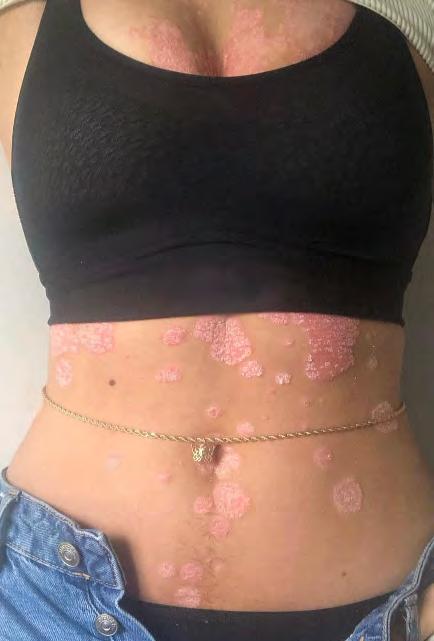
Molly Mathews, aged 21 bravely speaks out about her experience growing up through her teenage years with psoriasis, a skin condition known to spread over a person’s body. At the age of just 12, Molly was diagnosed with scalp psoriasis, nail psoriasis and plaque psoriasis; just as she was beginning her teenage years. Teenage life can be so tender as you are developing into an adult. However, not only did Molly have to deal with those uncontrollable teenage hormones; she was also trying to accept her ‘new’ skin that was beginning to take over her body. Overcoming the battles that she has faced with her condition growing up, Molly has accepted the skin that she is in and feels proud and delighted to speak to me about her experiences with psoriasis.
Q: What is the name of your condition?
A:I struggle with scalp psoriasis, nail psoriasis and plaque psoriasis, though these patches of plaque psoriasis tend to start as guttate psoriasis first.
Q: Can you briefly summarise your experience with psoriasis?
A: I developed psoriasis when I was in my first year of secondary school; so, I’ve had it for almost a decade now. I grew up with my dad, who suffered with psoriasis all over his body. I wasn’t too shocked by it, but it changed a lot about my life. It started in my scalp as scalp psoriasis and then loved down my neck onto my back and chest. I now have patches of psoriasis all over my body
Q: Tell me a bit about yourself?
A: I guess the best way to describe me would be that I’m a massive extrovert and social butterfly. I’m currently a final year student studying a joint honours degree in Classics and English Literature. I’m also president of my university’s Kpop dance cover society, which is such a great space to be. Socially, there’s a lot more acceptance than in some other social spaces at university. I currently live at home with my parents, and I’m honestly blessed to have a massive support network which is my friendship circles and my parents (and cat- he’s the most important). I love making new friends and meeting new people and just getting to talk about mutual interests or just hearing them talk about something they’re passionate about. I love seeing people be passionate about things, I love hearing about what people love, it’s the best thing in the world. I think if I was to say my life has one meaning, it would be to experience and put out as much love as possible which is why I enjoy posting about my psoriasis. It’s a way to hopefully help people love their skin the same way I love mine.
Q: How much has this condition affected your confidence?
A: Initially, my confidence took a massive hit. I was pre-teen in an all-girls school, scared that I would be mocked for something I couldn’t control. My dad is very insecure about his skin and so I just adopted his attitude towards it. It’s hard wanting to just be a ‘normal’ teenager and having something you feel hinder your confidence. As I got older, I just got tired of hating my skin and hating the way I felt in it. At 16 I started posting about my psoriasis online, finding new ways to see my skin for more than it was. One of the ways was seeing my skin as flower patterns on my skin, which I still do to this day because I think it’s such a wonderful way to view psoriasis. It eventually gave me the confidence boost that I never expected it would, and I think I’m more comfortable in my skin and more confident in my body because of it. There are days where I get self-conscious still, but growth and self-love are about being able to recognise those days and move through them.
Q: Has your condition deteriorated as you have aged, or has it gotten better?
A: My psoriasis has deteriorated as I’ve aged, but I think it’s more of a stress thing.
As you get older life becomes more stressful and my psoriasis just grows with the stress of university, work, and life in general.
Q: What treatment have you been offered and has any of this treatment helped?
A: I’ve been offered light therapy which I had when I was 17/18, but nothing else beyond the standard T-gel and moisturisers. Light therapy improved my skin beyond anything I had ever used before. Admittedly, I did look a little bit like a sweet potato during the process because it also tans you. However, my skin improved massively and stayed in a good condition for several months after, which isn’t common for psoriasis treatments.
Q: Are you afraid to show your flaws and are you happy in your own skin?
A: I definitely used to be. You care so much about how you’re perceived as a teenager and while that doesn’t completely go away as an adult, I think you learn to accept that everyone you meet will always have a different world view from you and all you can focus on is how you view yourself. I love showing off my skin now, it’s largely on my abdomen and back so I love wearing crop tops and low-rise things to show it off in its full glory. I honestly think my skin is beautiful, I know people tend to view psoriasis in a much more medical light than they do things like vitiligo, but I think psoriasis deserves to be seen as just as beautiful. I’m happy as long as I’m keeping it moisturised and keeping the itching at bay.
Q: It is so inspiring to see you spreading awareness, how do you spread awareness for psoriasis? What’s the best social media platform to voice awareness on?
A: I used Instagram predominantly. I’ve posted about it on TikTok before, but the formation of that app doesn’t allow for communities to be formed the same way they are on places like Instagram or Twitter. I think honestly Instagram is the best. It’s a photo/video focused app, so it’s great to show off your skin with a thoughtful or fun caption. There’s a feeling of community on that app that I don’t feel exists for people with psoriasis on Tiktok or even Twitter.
Q: What would you say to other people with your condition? How should they deal with it and feel confident about themselves?
A: Your skin a journey that only you will truly understand, and that’s okay. Find support in any way you can, whether that be doctors or family or friends or social media. Take it a day at a time and care for your skin the way you would a house plant or pet. Keep it hydrated and keep it loved. Confidence can take a while to find but there’s multiple ways you can go around it. Try not to fight your skin, it may be with you for years or decades or life; the longer you spend fighting it the longer it will take for you to love it. Learn to co-exist with it if anything. Find something that makes you see it as beautiful- for me I like seeing it as natural flower tattoos, but you might like seeing it as cheetah print or a world map. Find the beauty in your skin and you’ll find confidence in it too. It makes you unique in ways that other people don’t get the opportunity, no one else will ever have the same patterns on them as you do, which I think is so cool. Know to not fight your bad days, you don’t have to accept them either, but they will come no matter how much you don’t want them to; you must just find ways to cope more than anything.
A: It contributed to issues I had with my body image that I had already developed before my psoriasis appeared. I’ve been lucky enough to be able to work through them and I’m at a point where my psoriasis holds no stake in my mental health. I’ve struggled with depression and anxiety for a large part of my life and a lot of people with psoriasis do, I think knowing that helps you feel less alone, less like an anomaly.
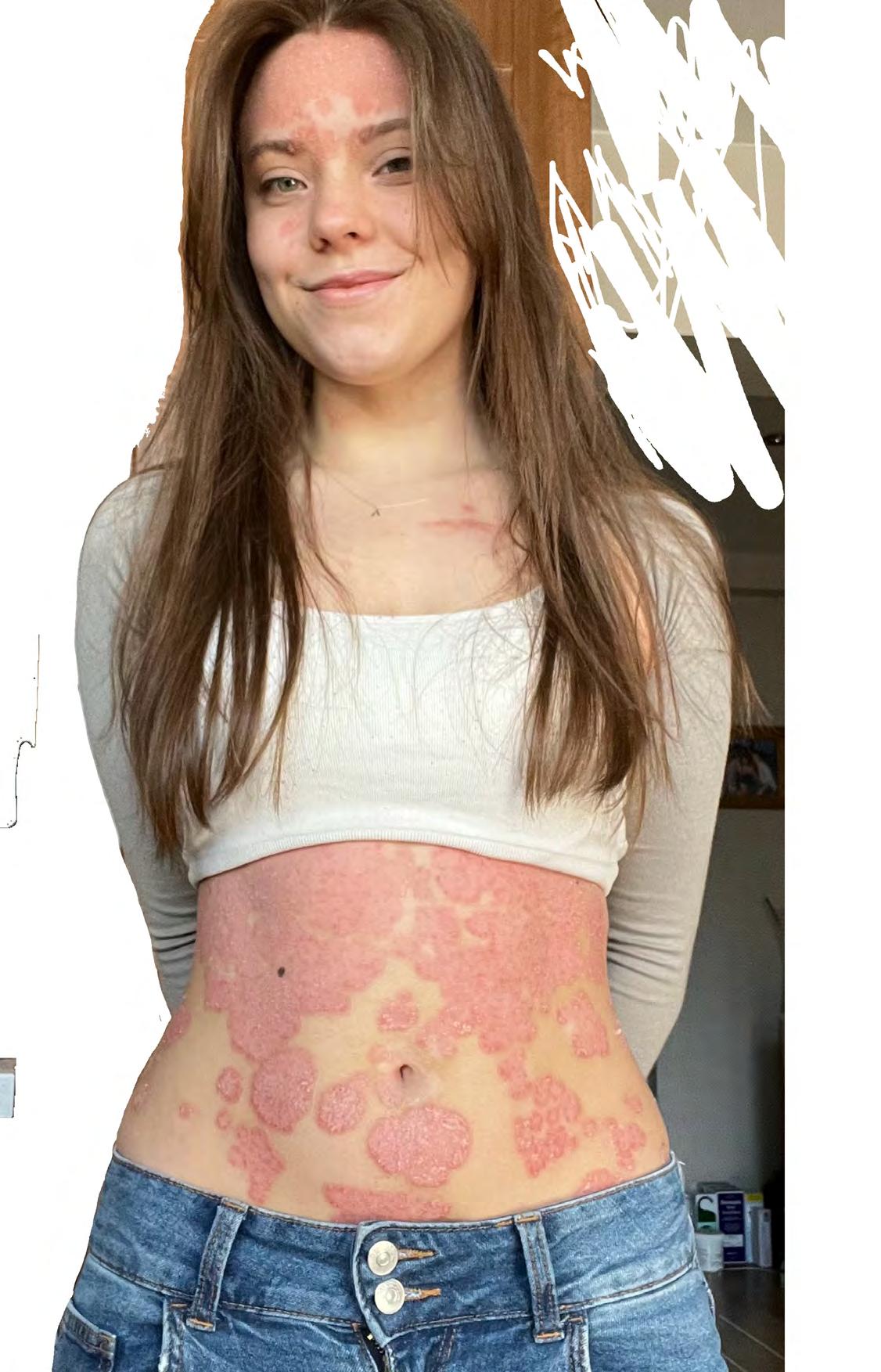
“Your skin is a journey that only you will truly understand.”
Q: Has anyone inspired you with the acceptance of your skin?
A: I got asked this recently and honestly it is hard to give an answer. There’s not a lot of people who accept their psoriasis outside of social media and even then, you must search for those people. People like Kim Kardashian speak openly about it, but I always feel like the general vibe is not acceptance when it comes to Hollywood and psoriasis. I’m glad she shows her struggle, but I feel conflicted about it, wishing the wider media was more open to talking about psoriasis in a positive light and not just using our struggles to pity us.
Q: Who has supported you the most since you have been diagnosed with your condition?
A: I guess my family have supported me the most; though my dad hates his skin and feels guilty about me having psoriasis, so it’s a complicated relationship. My mom has been great, she’s proved that psoriasis doesn’t stop someone from loving you, which was important for me to see growing up. Even though she doesn’t have psoriasis herself I think she’s the person who understands me best after my dad.
Q: Do you think it’s important to embrace the differences in skin and different skin types?
A: Ab-so-lute-ly! Yes! It so so SO important! Our differences are what make us interesting and make us our own person. Whether those differences are hair colour, hobbies, or skin types, they all make us who we are and we should always embrace them. I think in the age of social media where appearances seem so important, it’s vital that we embrace the things that make us different. I love different skin types, I play DnD and make sure every character I play has unique skin, sort of a reference to myself but also because unique skin is BADASS!
Q: Do you believe that there is more of an acceptance of people with diverse skin types now compared to when you were younger?
A: Completely. Don’t get me wrong, you still have to deal with ignorant people here and there but there’s a greater acceptance especially amongst my own generation. I can have conversations now with people who have eczema and they’re much more relaxed than those I had when I was a kid, where it would always be a conversation that expressed frustration or displeasure. Now me and my friends joke about how dry our skin feels in a fun way that’s far less self-deprecating.
Q: It seems that there is now a wider variety of acceptance of skin types that are used for ads and makeup brands etc. How does this make you feel?
A: I feel more acceptance when it comes to social media campaigns especially from smaller companies or brands that are targeting people with skin conditions specifically. I would love to
see it more commercially, and hopefully as time goes by, we’ll start to see that. I think if a model with psoriasis made it into a high fashion advertisement, I would cry a little for all the girls like the younger version of me, who wished to see her skin condition in places like vogue.
Q: You seem to be very proud to show off your condition on your Instagram. What made you create this page?
A: My Instagram page started off as just a personal account I had since I was 12. If you scroll far enough you can find the posts of me when I was probably 14 and trying to be ‘aesthetic’. My first post about my psoriasis is from 2017. Most people following me at that point where just friends from school and social activities, but I wanted to speak openly about accepting my skin because so many people in my life pitied me for it, even if they didn’t say it aloud. I wanted to post more about it when I found the tag ‘getyourskinout’ and found an entire community of people also accepting their skin.
Q: Has spreading awareness helped you mentally and not to hide away?
A: Definitely. I think once you put yourself out there and openly talk about it you’ve already ripped off the band-aid when it comes to not hiding away. It’s hard to want to hide away when you’re already showing off your skin for the world to see online.
Q: How has your Instagram and social media helped to spread awareness about psoriasis?
A: I’m not too sure about my impact personally, I’ve definitely had people tell me that my account has helped them or their loved ones, but I think just contributing to the community is the biggest thing. Letting people know that there’s so many people out there who understand them helps make people feel less alone and isolated in their struggles.
Q: When has psoriasis affected you the most during your childhood?
A: I would constantly worry that no one would find me attractive, which occupies a lot of your mind when you’re a teenager. I genuinely believed that I would never get to experience love the same way that my friends do, just because I thought no one would love me because of my skin. That took a lot to work through and I still worry about it now as dating has turned so virtual with dating apps, but at least it helps me weed out the fickle ones, I guess?
Q: What else have you done to help spread awareness for psoriasis?
A: I’ve taken part in some ad campaigns for companies as well as campaigns for LEO Phar ma. I used to write blog posts for them too which was super fun. I had my story in the metro once, that was fun!
“ I describe myself as a massive extrovert and social butterfly”
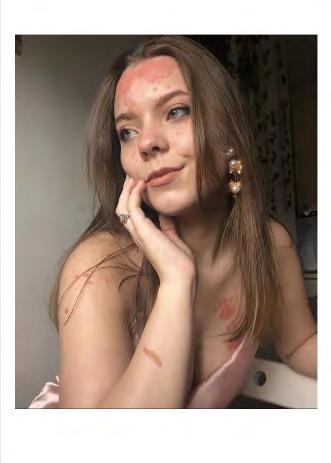

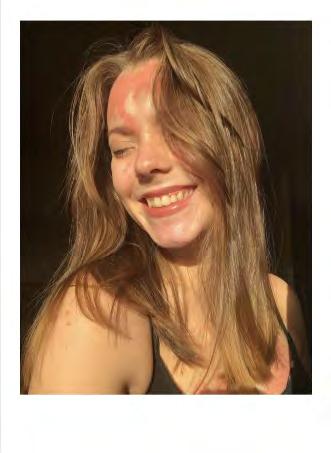
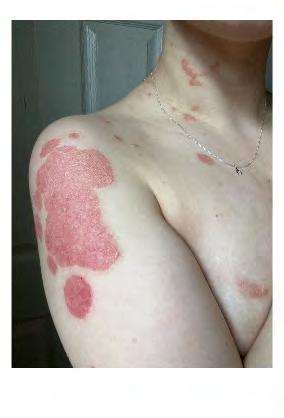
No matter how much some people try to ignore the problem, our environment is in serious danger. With the fashion world growing and changing at a fast pace, it’s no shock that the industry produces 10% of annual global carbon emissions. It’s time for people to become more aware of the serious environmental impact of our clothes and make a change.
Want to be a part of this change? Well, one way is to be more sustainable with fashion and buy clothing that is created and consumed in a sustainable way that protects both the environment and the people creating the garments.
Could you tell us about your business/events and what you aim to achieve?
Sustainable Fashion Week is a platform created to support indie, emerging and student sustainable designers. More importantly it is used to spread sustainable fashion awareness worldwide. We travel to different cities spotlighting designers and educating consumers on their ethical shopping options.

How do you, as a business, promote being more sustainable with clothing?
Educating the consumer is a priority of ours. We do that by hosting upcycling workshops, swap events and panel discussions. Our shows would be the ultimate way of promoting sustainability with clothing as it shows the limitless possibilities of how you can be sustainable via design, fabrics, and recycling.
What is the importance of being more mindful when buying clothing and how will this help the environment?
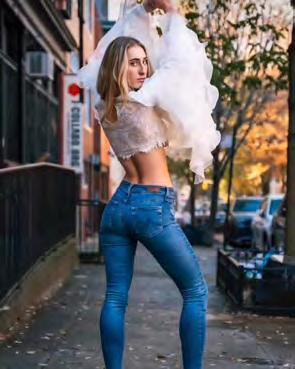
When a consumer is more mindful when shopping it shifts the overconsumption mindset. Thinking first on whether you actually need what you are buying creates an ethical moment for the shopper. The minute you think about your shopping decisions is the moment where change happens. It helps the environment because any shift in shopping habits starts to slowly push the needle of having more conscious shopping.
What are the main benefits of buying items of clothing that are sustainable?
1.Long lasting wardrobe
2.Unique and well-defined Style
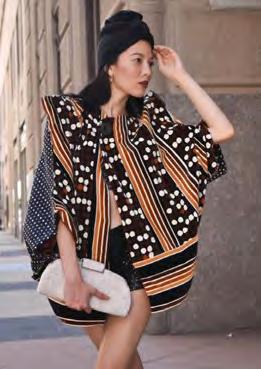
3.Knowing you are helping the environment

4.Sustainable products assure better work environments
What is the importance of buying quality clothing, rather than quantity?
As mentioned above with buying quality clothing you are guaranteed your items will last longer. With your items lasting longer you will consume less. An effective sustainable campaign has been “Loved clothes last” so when you spend more on an item, chances are you will cherish that item. When you buy a bunch of lower quality (fast fashion) you are buying clothes that most likely have been made under very bad conditions and won’t last very long, so why would you support that just to have a few more pieces in your wardrobe?
Adpot a more mindful approach to clothing by building your own capsule wardrobe. This article includes everything you need to know about being more sustainable and achieving your very own capsule wardrobe.
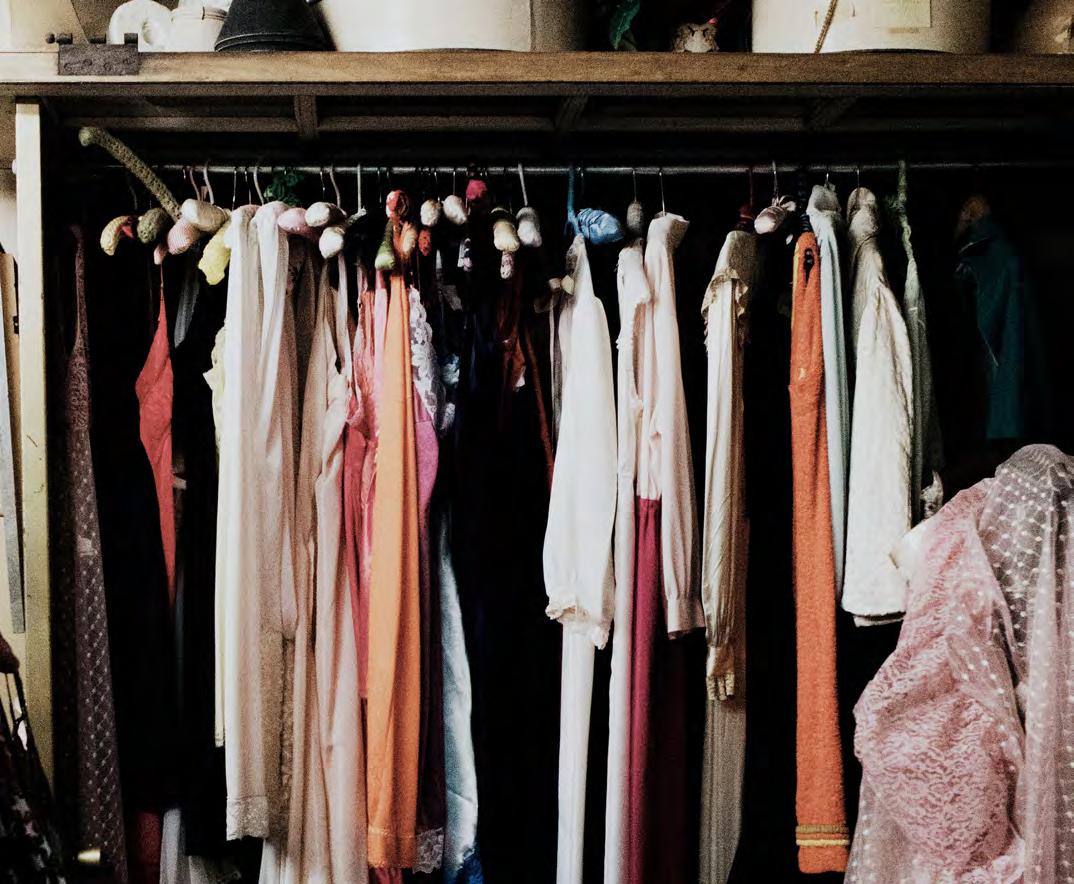
 By Madeleine Grice Woods
By Madeleine Grice Woods
There are certain scenarios when you just need the perfect outfit. A night out with the girls? An important meeting at work? Or maybe you’re just having a chill day but want to feel cute and comfy. The trouble is, does the perfect outfit even exist?
If you’re anything like me, you’ll spend at least an hour everyday looking through your wardrobe, trying on hundreds of clothes, asking yourself ‘Why don’t my jeans fit?’ ‘Is my top too tight?’ ‘What if my dress is see-through?’
Picking out an outfit can turn into a whole ordeal, and that just isn’t working out for me, because who has time for that? We should feel confident in our clothes so that we can feel comfortable throughout our day.
I wonder how I could adapt my wardrobe to make picking out an outfit effortless, but also how I could be more sustainable when purchasing clothes. It isn’t until I am scrolling through Pinterest that it hit me. The items I see all have one thing in common; they can easily be mixed and matched over time to create hundreds of different outfits.
Having a limited selection of interchangeable clothing pieces that complement one another is known as a capsule wardrobe. Most of the time, these are classic clothes that never go out of style, and are overall composed of neutral colours. Building a capsule wardrobe allows you to present yourself to the world with a small collection of well-curated outfits that you buy with intention, but most of all, love.
The concept isn’t new at all. It started in the 1970s when a woman called Susie Faux opened the ‘Wardrobe’ boutique in London, with the goal to make women feel confident in how they presented themselves. She sold minimalistic clothing that was adaptable, made of high-quality material and that could easily be mixed and matched.
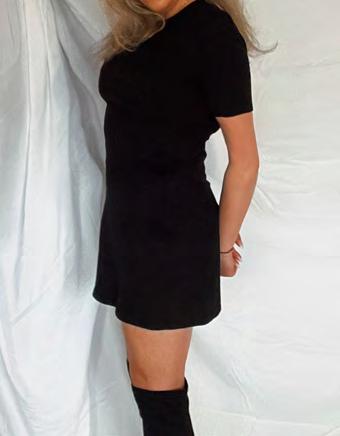
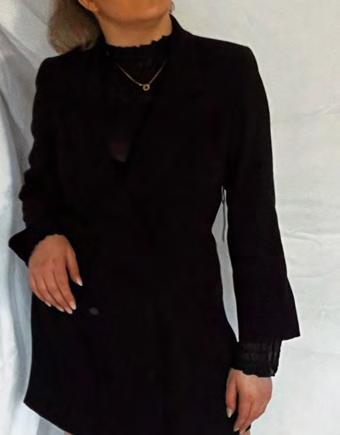
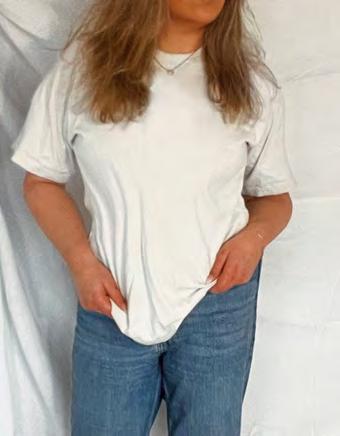

Later, in 1985, the concept spread to the USA, where designer Donna Karan released her line of Seven Easy Pieces. The line showcased several outfits on models, all composed from the seven pieces. The show was such a success, the idea of having a minimalistic wardrobe spread across the world.

Go through your closet and assess which items you wear regularly and the ones you never touch.
2
Think about what activities you do and what type of lifestyle you live, to judge which items you’ll be needing. A good question to ask is, ‘Have I worn this in the last few months?’ If the answer is no, then toss it into the unwanted pile.
3
Pick some clothes you love and how many of each item you’d like to have. This will depend on the climate that you live in, lifestyle and how often you do laundry. A colour scheme such as neutrals, white, black, and navy work well together as with any other colour.
4

1 5
Once you’ve got your basics, add some colour! What colour will match your skin tone, eyes, and hair? Do you like V-neck tops or baggy tops? Skinny or mom jeans? These are the important questions to be asking yourself because your clothes should look flattering and fit your body type.
To complete your capsule wardrobe, you’ll need to let go of the clothes you don’t want to keep. Decluttering is key! But remember, being sustainable is important, therefore instead of taking your clothes to the dump, try selling or donating them. Never get rid of everything and then try building a capsule wardrobe from scratch – this is not sustainable and to be honest, so much more expensive!
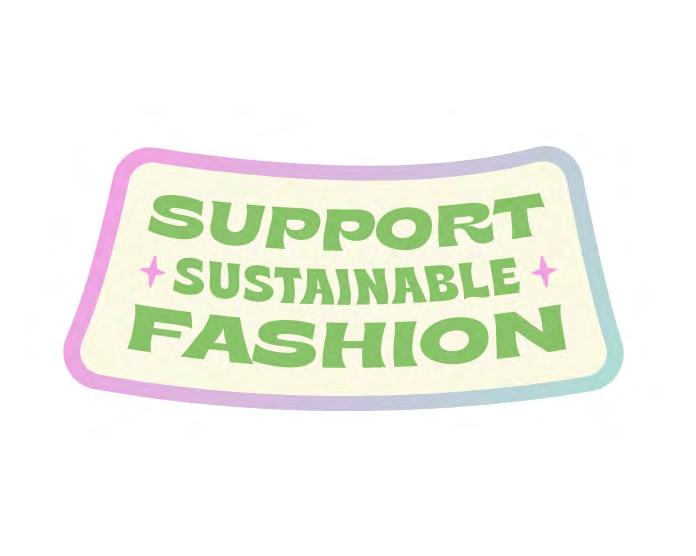
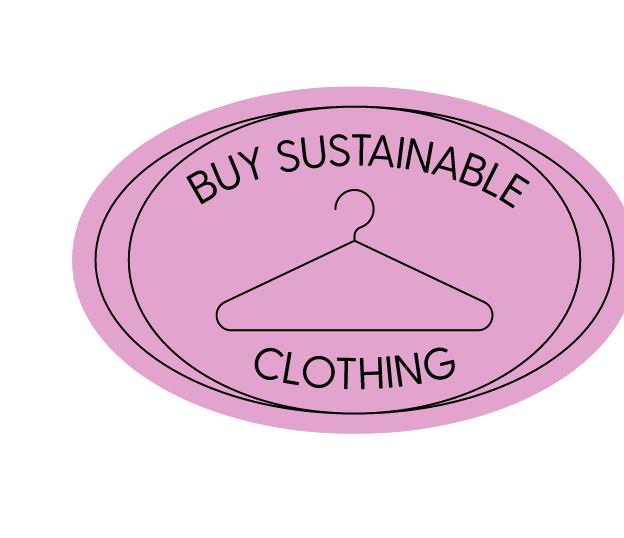
Not sure what to get for your capsule wardrobe? Here are some ideas:
Neutral coloured t-shirts
A pair of black jeans
One or two pairs of jeans
A basic black dress that can be worn for any occasion
A basic pair of sneakers – white ones go with everything!
Another thing to keep in mind is the quality of your clothing items. High-quality pieces last a lifetime. Investing in your wardrobe may seem stupidly expensive, but over time, you’ll be thankful that you spent that extra bit of money on an item of clothing because you’ll still have it when you’re 80!
And if you can’t afford that, I always love shopping through my mum’s old clothes. If you’re lucky, you’ll find some absolute golden pieces, and word on the street is that vintage is making a comeback! With time your wardrobe will grow, and you might even decide to switch up your style a bit – and that’s ok. We develop through life, and so should our clothes. But the benefits of a capsule wardrobe will never change.
Not only will it make your life so much easier, you’ll be able to strut your stuff on any occasion, knowing you look insanely hot.


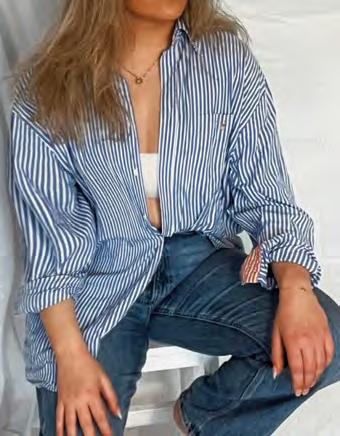
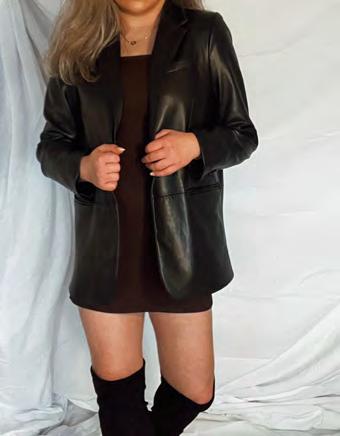
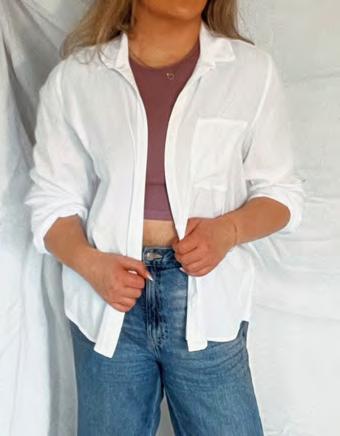
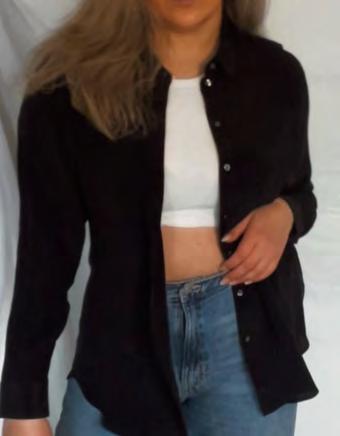
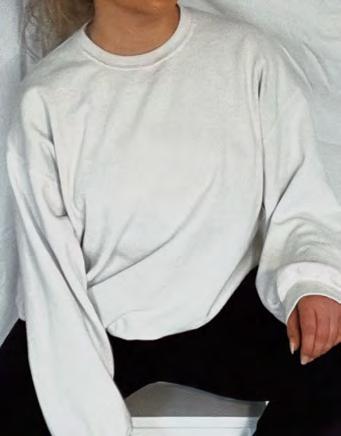
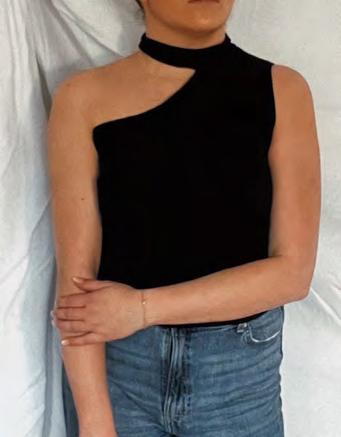

I spoke all things mental health and positivity with Miranda and how we all need to have a little self-care and falling back in love with ourselves
by Chloe BoultonIt’s the start of the day. You’ve picked out your outfit, done your hair, makeup applied how you like it, and look yourself up and down in the mirror. ‘I look good, I feel good, I am me.’ That’s the mantra we should say to ourselves every morning, to know we are worthy enough, that a little positivity and loving yourself goes a long way.
The 21st centur y has redefined what it means to love yourself, whether that is sexually or mentally. However according to the Mental Health Foundation, in October 2021, one in five women were dealing with a mental health problem. This was affected by many factors, such as physical and sexual abuse, life events and hormonal changes, poverty, or social isolation.
To combat this, campaigns on social media and other platforms have honed in on positivity and well-being, with more people, including celebrities and influencers, opening-up about what loving yourself means. I spoke with sex therapist, Miranda Christophers, about sexual diversity, social media, and self-worth.
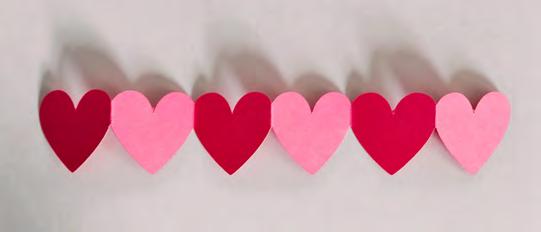
Why does she think so many people struggle to love themselves?
“Experiencing trauma or attachment difficulties in the affect somebody's ability to love themselves.” Miranda explains, “Somebody will be more inclined to love, and be able to love themselves, if they've experienced healthy relationships, both in childhood and in adulthood. So having experienced love and respect, when we see that model, whether it's what we're observing or what we're experiencing ourselves, then it becomes a lot easier to naturally experience positive regard towards ourselves.”
Social media, despite all its beneficial use and networking, can also be a very debilitating place, and has significantly become prominent in our everyday lives. We constantly scroll through photos and stories from celebrities and influencers possibly thinking ‘why can’t I be like them?’ ‘Why can’t I have this perfect life?’
“Social media puts us under more pressure to feel like ‘am I good enough?’” Miranda expresses her views, “I follow lots around it see lots of discussion around mental health and self-esteem and relationships and sex. There's a lot of information out there. So, like people are constantly questioning How do I make sure I'm not a narcissist? How do I make sure I'm being really considerate of everybody else? How do I make sure I love myself? How do I make sure I have a good relationship? How do I make sure I'm kind of positively embracing sexual positivity? It's tough. Conversations are happening. It’s good. But it can be it can be a lot of information at once.”
‘It’s amazing that people are able to step out and say, ‘do you know what, this is who I am’

Miranda believes it’s important to have steps you can take to love yourself. “What are your values, what do you like about yourself? Even just one or two things. What would your friends or family say about you?
Think of a few people, because people see different things, and then you can start to build this idea that you know what, actually, I've got a lot going on, and I am lovable because everyone's lovable. It's just sometimes it's harder for them to see and sometimes they're resisting that with others and themselves for a variety of different reasons.”
Loving yourself also covers how we love ourselves in relationships and how we feel in them. “Love doesn't have to look the same, relationships don't have to look the same. And as people we are all different, diversity is fantastic and makes for a very interesting world, LGBTQ communities have also spoken up in recent years about sexual diversity, love, and relationships.
“People have stepped outside the box of what was deemed the norm. But 100 years ago, we'll say or at any point, even if we're thinking about gender diversity, now people have gotten brave, and that's great. It's amazing that people are able to step out and say, ‘do you know what, this is who I am’ And this is really important to me.”
“And obviously, we say this all the time. You know, obviously I've mentioned gender and sexual relationship diversity and we may see that in kind of like consensually non monogamous relationships as well but also, obviously, in terms of cultures and other ways in terms of religion, and cultural diversity so that people do step out and people are due to take those steps, but it's not easy to do.”
1.Ask yourself what stops you from being able to love yourself? Then begin to look at what you have, for example earning your own money, or the support of others. Then work on this by talking to friends or seeing a therapist.
2.Get to know yourself and what makes you you. What makes you tick? What do you what you actually like? What are your values? Check in with your own authenticity.
3.Imagine you're standing on the ramp standing second person, so you're imagining perhaps you're your friend, looking in, or looking at the outside looking in. What would you then say, if you weren't being you? Could you be a little bit more complimentary about yourself?
4.There is a beauty in being unique and yourself and not being a sheep. Be true to yourself. In regard to body images and self-images, where do we get these ideas of what something should specifically be looking like, how do others find us attractive, or others are able to love us?
The on-going debate on whether sportswomen should be paid equally to men has been around for decades, and even with massive improvements in equality elsewhere, when it comes to the world of sport, we are much further behind.
By Lucy SwiftIn January, it was announced that for the first time ever, men will be contributing to women getting paid equally in football. This is due to the Welsh men’s team agreeing to take a 25% pay cut to make it possible for both teams to be on the same wage. ‘We hope that this will allow future generations of boys and girls to see that there is equality across Welsh international football, which is important for society as a whole’ Gemma Grainger, Wales’ football manager explained. However, the news hasn’t gone down entirely well. When this was announced on twitter by BBC Sport, no one held back in the comment section. ‘An absolute joke’ one man wrote, ‘I assume that the women will get the crowds attendance and the crowd will be charged the same amount to watch the games’ hinting at arguments to why there is a pay gap in the first place. Another wrote ‘So in relative terms the men now are paid less than the women.’ The plan did receive some praise though (even if it was only from women!) ‘Leading the way to true equality in sport. Bravo!’
However, we must shine a light on male professionals in the sport that feel strongly about the pay gap closing. Julian Alsop, a former professional footballer, is an encouraging role model to both men and women in the sport, as he openly agrees that the pay gap needs to close. ‘Realistically, women’s lower-pay boils down to who is in charge at the top of the sport’ he says. ‘However, this should change in the next 20 years, as women are continuing to have more power in board rooms and higher up in establishments. It’s good the world is changing in this way’ he continues positively.
In terms of females feeling the need to have a job alongside their football career, Alsop says, ‘Effectively, this can happen to both sexes in the sport. Sponsors are the cause really, as they are still more likely to foot the bill for men’s teams rather than women’s.’ The Welsh men’s team agreeing to a decrease in wages to allow for equal pay is a step in the right direction in Alsop’s eyes: ‘More teams should be doing
Does the stereotypical male in the sporting world still have a condescending view of the gender pay gap? We meet a former footballer and a male football writer to find out...
this for sure! However, the top international teams should be recognised for donating their match fees to charity too.’
Regarding any worries some fans may have over women’s pay increasing, the former professional explains: ‘There should not be any negative effects. Although one thing to consider is the potential bad feelings from the men in control at the top. Their egos could be a problem!’ he jokes. So, who is at fault for this inequality? ‘No one is to blame for the pay gap, but it needs to change as soon as possible. I think it’s good that the clubs have now realised that there is a need for women’s football.’ He continues, ‘Hopefully they can use this as a tax incentive to defer the clubs’ tax bill for men’s football.’
Julian’s advice to sportswomen looking for more changes towards equality is simple: ‘Keep winning and use social media as a positive!’
Jon Palmer, a football writer and author with 20 years’ experience, has seen changes in attitudes towards female footballers over his career. His opinion is very clear: ‘Women’s pay increasing is long overdue. It should be accepted and welcomed by all concerned’ he says bluntly. ‘Decades of discrimination in sport can be blamed for the pay difference, as well as outdated historical stereotypes, and although things are slowly improving, there is much work still to be done to redress the balance.’

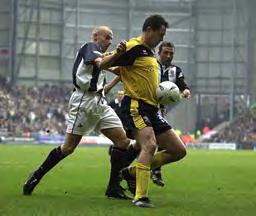
The England women’s Euros success has been a great steppingstone for improvement in attitudes towards female football. Speaking on this, Jon says, ‘This should help speed up the process of gaining equality, but time and further steady progress is needed as it can’t happen overnight.’ Even though there are more fully professional female footballers now, there is not yet as much depth as in the men’s game - where the top five divisions are almost entirely professional. When it comes to why female footballers often need another job alongside their sporting career, the football journalist says this missing depth could be the reason why, before adding, ‘Some of the leading female players are earning a more realistic salary now and as the game continues to grow, hopefully more money will filter down to the lower levels so investment can continue to be made.’
It’s only right to highlight the fact that those campaigning for equality are not trying to insult men in the sport. Jon explains ‘Nobody can criticise male footballers for the money they earn or begrudge the popularity of their sport, but the pay-gap should undoubtedly be reduced.’ Could clubs be doing more to encourage equal pay? The football journalist believes, ‘more investment in women’s junior sections, with joint ventures and all teams from one club playing in the same kit, along with branding and events involving both male and female players, this would raise awareness.’
So, what is currently out there to help raise awareness for female teams? ‘Broadcasters and media have a key role to play, because as the women’s game receives more coverage, its popularity will continue to snowball. The FA can play a big part, with distribution of wealth.’
Contrary to those on Twitter, the football writer was pleased to see the news of the Welsh footballers contributing to the women’s team. ‘They should be applauded and it’s another sign of the progress being made in recent years.’ He then goes on to say, ‘We’re still nowhere near where we should be yet, but we are much closer than we were a decade ago.’ It’s good to hear steps are being made to get closer to equality, and great to hear positive opinions from men in the sport, with Jon finally adding: ‘I have definitely noticed a change in men’s attitudes towards women’s football. Significant progress has been made in the 20 years I have worked in football media. Long may it continue!’
Julian Alsop Jon Palmer
“Women’s pay increasing... should be accepted by all concerned.”
Lewes FC is a small football club in the south-east with big aspirations and certainly deserve to be in the spotlight much more than they are. And why is that? They offer equal pay to men and women! Can you believe that? There’s no catch, just EQUAL PAY! The recently released statement speaking on their groundbreaking venture: ‘We’re the only club in the world that offers equal pay to both men and women. We are trailblazers in what we’re doing.’ Lewes FC’s director, Karen Dobres (yes, a woman!) referred to everyone involved in the club as ‘pioneers of gender equality in football.’ She then went on to add ‘we are known for our radical stance on smashing gender stereotypes.’
The move towards equality started back in 2017, when the club launched their “Equality FC” campaign. Not only pay, but resources, budgets, and equipment have all been equal for the men’s and women’s teams since. Fans could also become small shareholders of the club, for just £40! It is clear that Lewes’ fans are backing this campaign all the way, as the club now has over 1,600 owners! Attendance has quadrupled over the last six years, and the women’s team are getting nearly 600 fans to their matches every week. And it’s not just fans that love what Lewes FC stands for, as big names such as Lyle & Scott are now sponsoring them to continue setting new standards for equality.

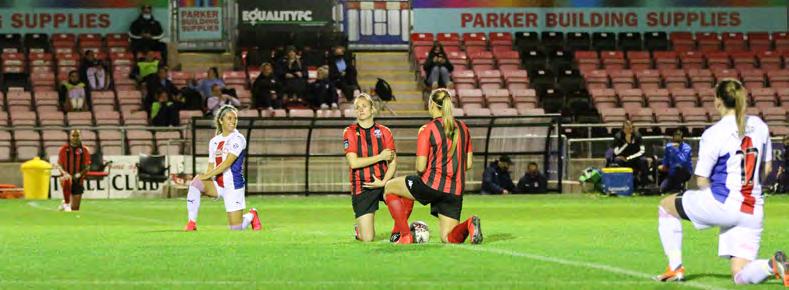
Just when you think the club can’t get any better, earlier this week, they shared a letter on social media that they sent to former Lioness Karen Carney, who is leading a review into women’s football, on the benefits of having equal prize money in the FA Cup. The whole letter is there for the public to see! It includes ‘Sharing the total combined prize fund equally between men and women has the power to be transformative in the women’s game.’
It’s not just gender equality that Lewes FC fights for. They also do a lot of work on anti-gambling and embody democratic governance and ownership. Possibly saving the best part until last, the club is completely fan-owned, volunteer-run and not-for-profit. Lewes FC, we applaud you.
Lewes FC women’s players taking a knee before their match. The Dripping Pan, Lewes FC’s stadium‘We are trailblazers in what we’re doing.’

“I am a Lewes FC Owner because I believe in the power of the community.”

Words:

There are so many incredible female writers and I tend towards those in a way I never did when I was younger. I lean towards female authors, but that doesn’t necessarily mean female characters. Female authors, BIPOC authors and gender binary, gender queer authors are featured in stories in a way they never have before, but I think it’s a drop in the ocean and we have a lot more to do.
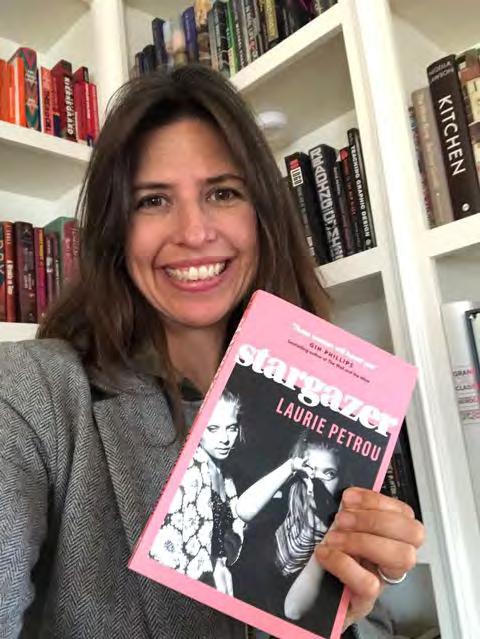
Winning the Half the World Global Literati Award for ‘Sister of Mine’, which was just a manuscript at the time, was a life changing moment for me. There’s a study where the majority of literary awards are awarded to stories, not necessarily by men, but about them as though their stories are more interesting and Sister of Mine is about the inner lives of women, by a woman. After I won that award, Harper Collins bought the book.
Publishing is so white. It’s nice to see agencies and publishers looking for own voices in books as part of their criteria. I think making a concerted effort to diversify, what still is a biased industry, has started. I have students in a class I’m teaching, of colour and from different backgrounds, writing stories about their own lives. I hope those stories will be capitalised upon and I hope they happen. I think there’s an appetite for difference, from both the publishing industry and from readers, that unfortunately and frustratingly hasn’t been in the past.
I grew up in the suburbs outside of Toronto, but now I live in a small town called Grimsby, Ontario. I went to school for fine art, I was always an artist. In school that’s what I was known for; it was kind of my thing. I then studied painting at Queens University, it was a really small programme in an Ivy League setting; they only accepted 30 people a year. It was really great and so much informed the art school in my book, Stargazer. I became an interactive web designer, I found that soul sucking. In the meantime, I was showing my art in small galleries in Toronto.
I was always writing. At Queens, I wrote for the literary magazine. I was always writing poetry and short stories when I was doing my masters. I had a handful of short stories, so I sent them to a small press in Toronto. A friend had been doing some painting for book covers and told me I should send them to Pedlar Press. They said, “get in touch when you have enough for a book.” I wrote for another year until I had a ‘books worth’ and it was their first Pedlar book of short stories. I didn’t really know what that meant! It was in the Top 100 Books for the Globe and Mail newspaper, which is a huge deal here. It had good reviews and things started to happen from there!
I’ve had good luck my whole life. I carried on at school, I had two babies and this full-time job being a professor, I didn’t even know I would get an office. I just feel like in all steps of my life, I’ve fallen into it and figured it out. I really feel like I fell ass backwards into every piece of good fortune I’ve had. Sometimes it’s okay to have no plan. I just kept doing my thing and Ryerson supported it. Everyone has been supportive of my creative pursuits and never pushed me into a corner; I’m an anti-academic when it comes to that. After I finished my PhD, I stopped doing any academic writing and it’s been Full steam ahead with fiction ever since. The university tried to tell me not to, but I kept doing it anyway!
I do read my reviews and I defy anyone that tells me they don’t. I’ve been doing it so long that rejections don’t bother me and neither do bad reviews; I usually just flip the bird to the computer screen and then I move on! If a complaint is consistently said, then I address it in my next book. You let the sting wear off and think, ‘okay, is there something I can learn from this’. Good Reads is a home for readers, not writers. It’s a safe place for readers to talk about how they feel, so it’s not my space and don’t write reviews as a reader. I know what it’s like to have book reviews, so it’s not the sort of thing I engage in as a reader.


“I never considered not writing, that was never an option for me.”
My favourite authors have to be Heather O’Neill, Madeline Miller, Zadie Smith, Elena Ferrante, there’s so many, I need my bookshelf behind me right now! When I’m in a slump, I’ll take one of my favourite books, open it anywhere and read a few lines, that helps.
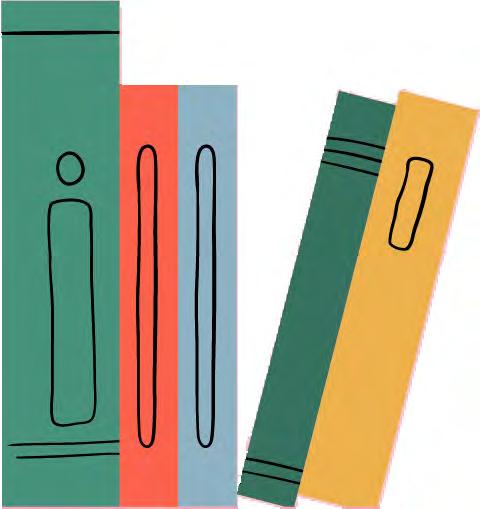
I’m a total J.D Salinger apologist, those books meant so much to me. My brother gave me a staple copy of The Catcher in The Rye. I fell in love. It was the first time I saw this informal, colloquial, youthful narrator in a way other books didn’t, it felt so relatable. I loved Margaret Atwood in high school too. Those books were such an open window to stories of really brave women doing wonderful and daring things, but Salinger had a young person’s voice. I read everything he wrote, and I became obsessed. I wrote hundreds of letters off into the ether.
*SPOILER* A book that made me cry… All Quiet on the Western Front. HE DIES! The narrator dies and that was so heart-breaking for me. He came back from war and was a different person. He was broken. I don’t usually cry when I’m reading but sometimes, I’ll read books and they’ll be too hard to read. Everyone said I’d bawl reading ‘A Little Life’, I was getting through it and I thought ‘I don’t know if I can read this!’ I can’t think of any other books I’ve cried at, which is not true to life, I cry all the time!
I did so much research into taxidermy for a book I was writing. I became obsessed, even though I have a squeamish stomach. I was watching videos and documentaries; I became friendly with this taxidermist who works in LA. She’s so glamorous and beautiful and works in Hollywood and does taxidermy. So, if it’s something like that, then yes, I’ll go deep. I’ll never write a book about a place if you don’t know the place. Readers love Stargazer because of the location and they want to go to Canada. People love books that take place in one particular place in the world, things don’t have to be everywhere. It’s less relatable.
I reached out to Taylor Jenkins Reid and sent her a copy of Stargazer. She put it on her best summer reads on Instagram and if I didn’t have the nerve to send it wouldn’t have happened. Having the courage to reach out is important. People who apply to the same contests to keep in contact with are important. None of my best friends are authors which is kind of a good thing, being part of those communities, not as a distraction to your own work, you can create beautiful friendships.
You have to be okay with failing. No one’s talking about all the rejections or bad emails from agents. Read other people’s work and connect with other writers. Stick to your guns, don’t shoot your mouth off, be easy to get along with and work hard.
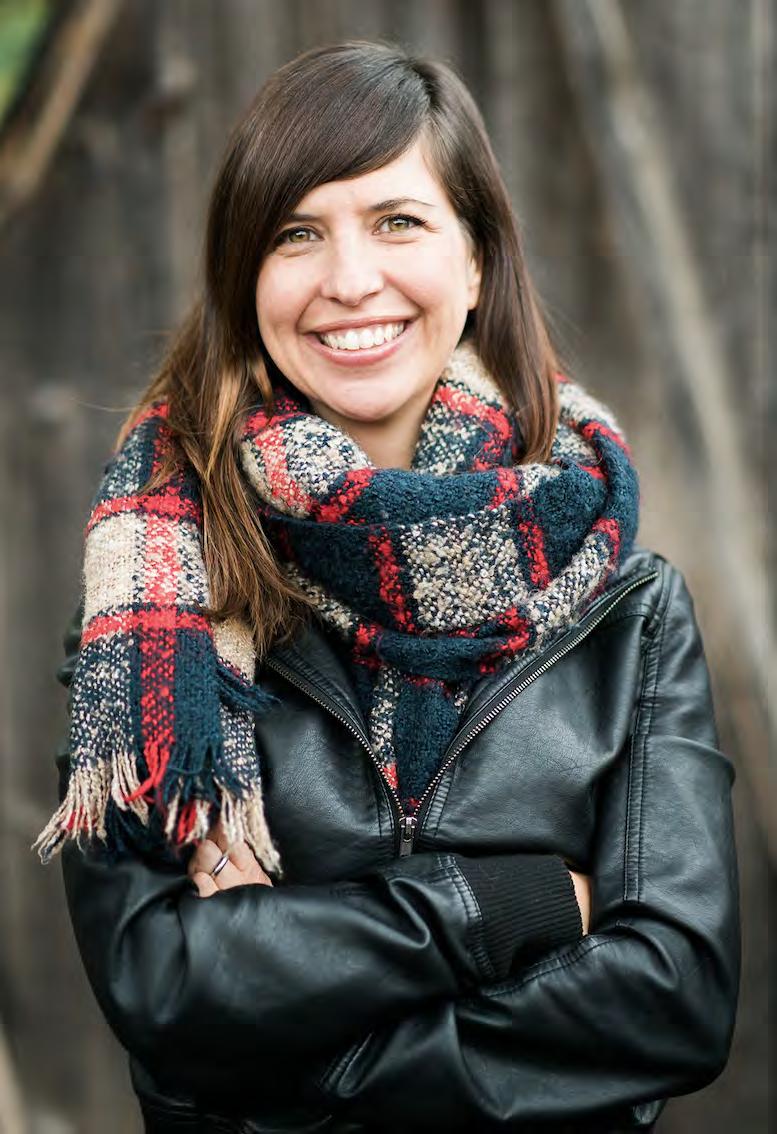
I’m on my 10th draft of a novel. It’s a brother-sister allegory of grief, taking a road trip to bury their mother. I never consider myself a thriller writer. I write suspense, kind of, but I was pigeon-holed into this genre that I don’t really read, or consider myself a writer of. We lost a friend in a terrible tragedy in a random act of violence a year ago and I don’t know if I can ever write about murder in the same way. It has impacted the way I see murder and death because I’ve experienced it in my family and friend group.
I’ve had my share of rejections, you can’t go back, so once you’ve been rejected by a publisher it’s back to the drawing board. I’m a very tenacious person, I’ve been so full of despair but I don’t feel like that anymore. So many things you don’t expect will happen if you keep going with your books. I’m an artist, I’ve always wanted to create art, so I kept doing it. I never considered not writing, that was never an option for me. It makes me happy.


“Having the courage to reach out is important.”
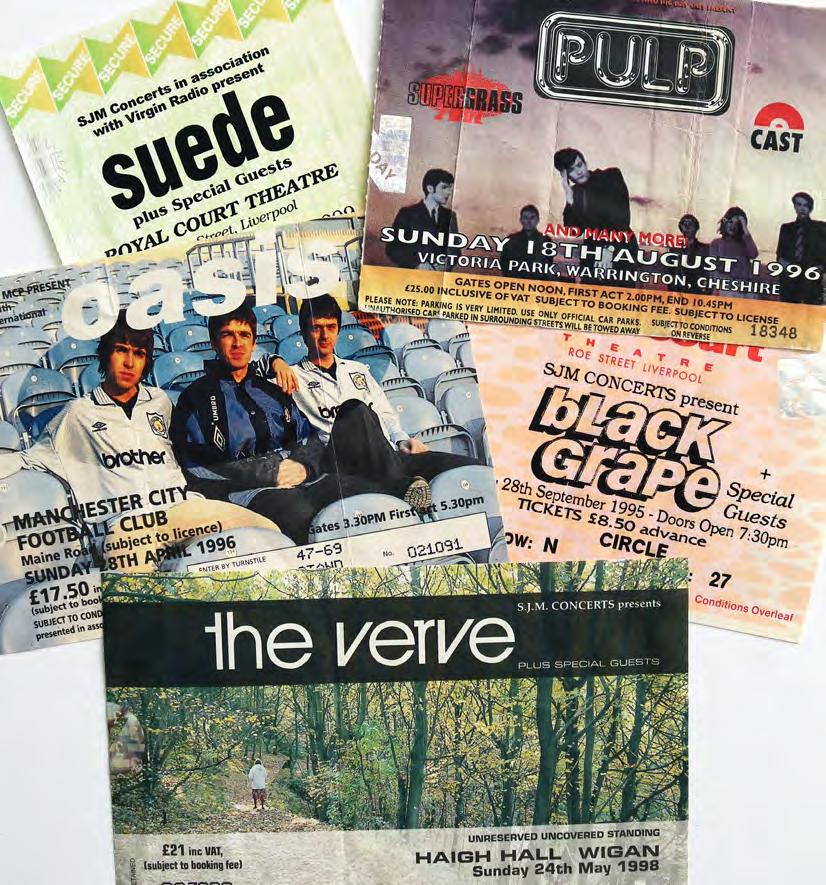 Words by Natasia Smith
Words by Natasia Smith
“I could see the trap in the ladette thing. It was saying: it’s all about liberation, it’s all about girls doing what they want – if they want to get their tits out, or watch football or drink beer, that’s great. The problem is for anyone who doesn’t feel confident enough to go out in a fucking negligee. And the girl that does, I can guarantee that she’s going to get a shitload of crap.” -Miki
BerenyiOver 30 years since the dawn of the scene, Britpop is still talked about and celebrated as one of the most influential British music movements. A direct counter to American Grunge and a resurgence of 60s-esque guitar music, the movement celebrated everything quintessentially British. When you think of Britpop, you might think of the Big 4. Oasis, Blur, Pulp and Suede completely changed the musical and cultural landscape in Britain. What started as a cultural revolution and diverse selfexpression by the bands mentioned soon turned into the epitome of “lad culture.” Tracksuits, football shirts, excessive drinking, it was a time where masculinity was praised and something to strive for. But amid this, plenty of women were proving themselves in the musical world and showing themselves to be worthy competitors to the men leading the scene. Some you may know, and some might not be as familiar to people nowadays, but here’s just a few of the female-led bands who didn’t let lad culture stand in their way.

Elastica formed in 1992 after frontwoman Justine Frischmann left Britpop icons Suede. Frischmann made a lot of headlines throughout the 90s due to her relationships with two frontmen of Big 4 bands (Brett Anderson of Suede and Damon Albarn of Blur), but her musical talents are just as worth talking about. She formed the band with drummer Justin Welch, and then added bassist Annie Holland and guitarist Donna Matthews, making the band ¾ female. Their self-titled debut was released in March 1995 and became the fastest-selling debut since Oasis’ Definitely Maybe, a huge accolade. With singles such as Connection and Waking Up, they showed their prowess and are still much-loved by diehard Britpop fans today, despite splitting up for good in 2001.
“They’re a big bunch of sex, that band Kenickie. They’re a big, raw-boned bunch of fucking sex — all three of them and the boy. I hope they get good. I hope we’re a good example to them, I hope this record’s huge and then the big labels will start sniffing around and then those big fucking raw-boned sexy Newcastle (sic) girls will be huge and have Number Ones and there will be an Amazon planet the way I want it.” -Courtney Love on meeting Kenickie
Lush were formed in the late 80s and were an early adopter of the sound known as “shoegaze,” though their later work adopted a more “poppy” sound as they tried to slot in more with other Britpop bands. For most of their short run, Lush consisted of singer and guitarist Miki Berenyi, guitarist Emma Anderson, bassist Phil King and drummer the late Chris Acland. They split in 1996, just after the peak of Britpop, after Acland tragically took his own life, and aside from a one-off tour and EP in 2015, have never reunited. Aside from their music, including hits such as Single Girl and Ladykillers, Berenyi has often been outspoken about the negatives of Britpop being such a masculine environment and some of the situations she found herself in, including a harassment incident involving Alex James, who she named in a 2015 documentary. She also published a book in September 2022 detailing more of her experiences and how, despite how many people see the 90s as a time for equality and “girl power,” that didn’t often translate to the artists and the fans of the time. That’s not to say that no progress was made at all, but it’s helpful for someone at the heart of the scene to call out the many problems and how men can always do better.
Sleeper’s frontwoman Louise Wener formed the band with Jon Stewart, Diid Osman and Andy Maclure in the early 90s. Despite not reaching quite the same heights as the aforementioned bands, Sleeper were an important part of the Britpop scene, with eight top 40 singles and three top 10 albums during their time, and reunited in 2017 and are still touring today. One of their most known singles is Inbetweener, and prior to its release they opened for Blur on their Parklife tour, giving them a great entry point to the scene. Wener, along with Frischmann of Elastica, were often featured on the covers of the music weeklies of the time, although sometimes this was due to their looks rather than their musical talent. Wener was, however, extremely outspoken on many issues, such as feminism and female sexuality, and this worked in her favour and showed that women weren’t just going to be quiet and let the men get on with it.
What made Kenickie so impressive, as well as having three female members out of four, was their age. Frontwoman, vocalist and guitarist Lauren Laverne was barely 16 when the band was formed, and despite not achieving as much chart success as the other bands mentioned, their boldness and the unapologetic way these schoolgirls (and Laverne’s brother, who became the drummer) jumped onto the scene and into the newspapers without ever doubting their place is impressive and has inspired plenty of other female-led guitar bands. They were unashamedly crude and sometimes sexual in their lyrics and media appearances, which sometimes led to some comments that wouldn’t be accepted about 15- and 16-year-olds today, but they weren’t interested in fitting in. They knew they had talent, they knew they had personality, and in the mere four years they lasted, they certainly made a mark.
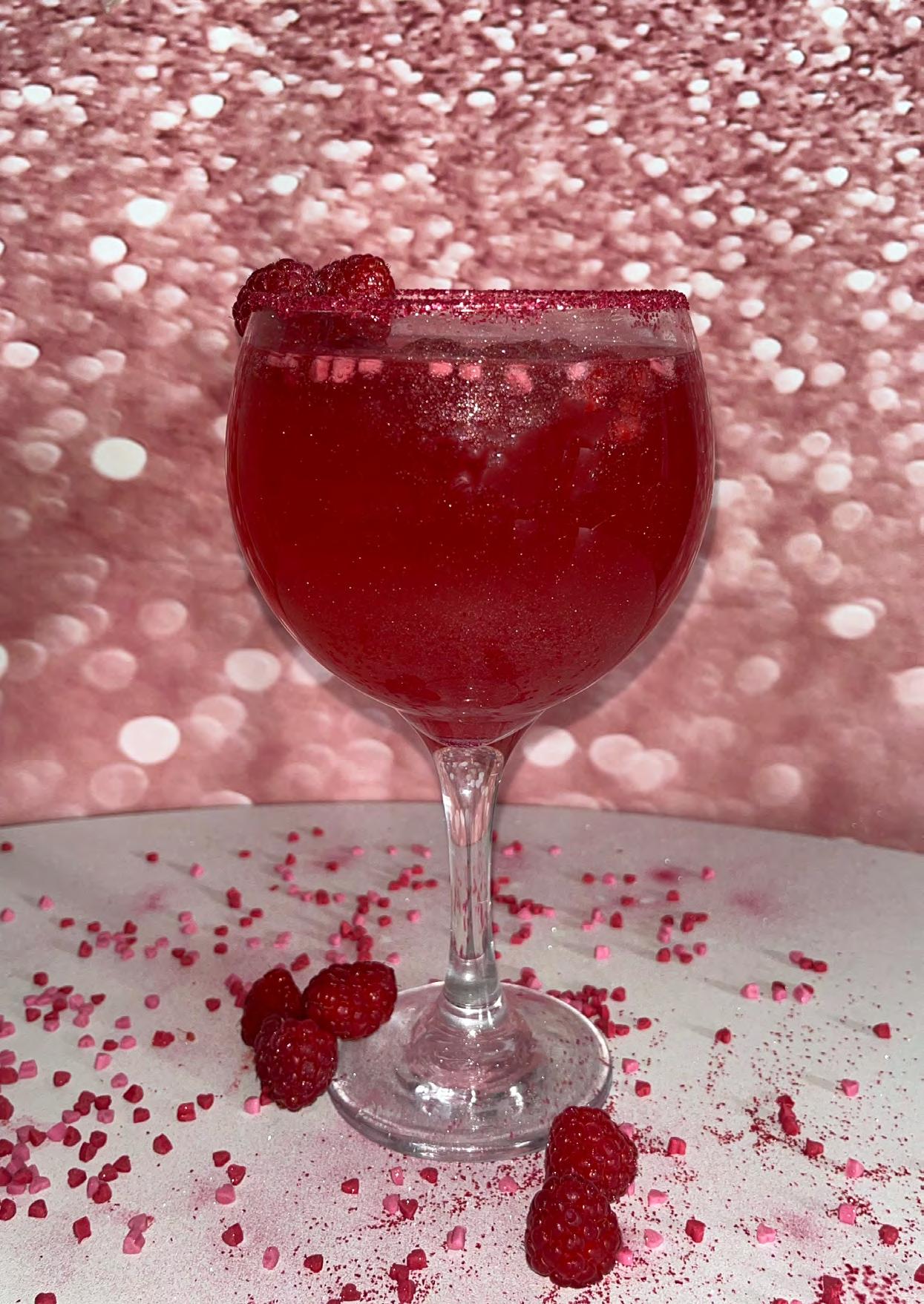

A stunning cocktail, including a fresh mix of raspberries and berries with an extra fine taste from the fruity rosé. Topped with glitter and sprinkles; this shimmering cocktail leaves a beautiful berry aroma.
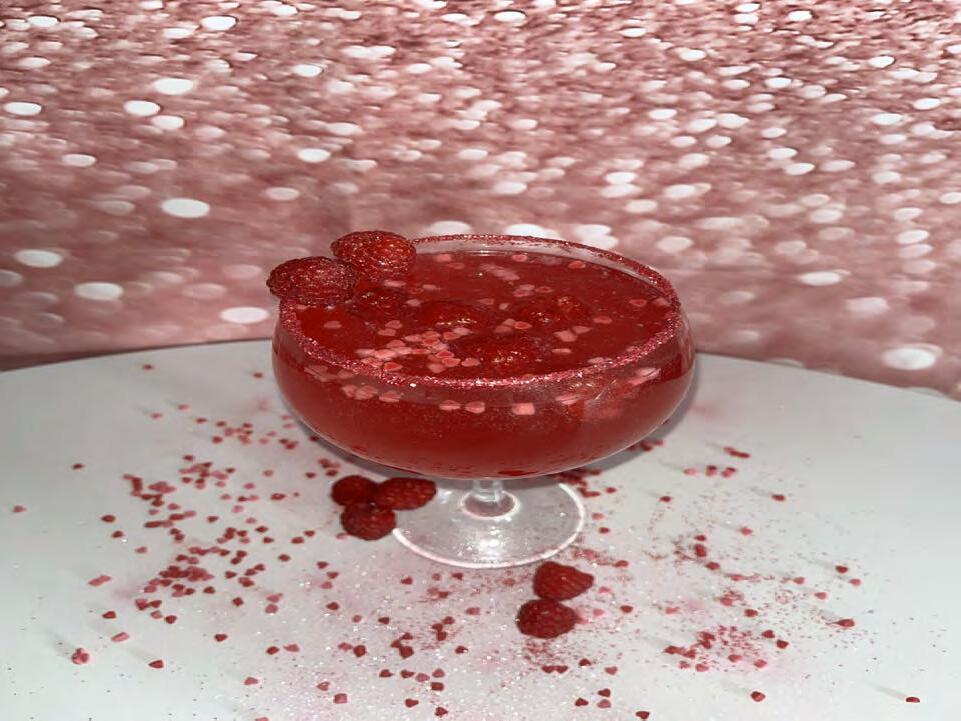
How to create the Athena Cocktail:
Five raspberries

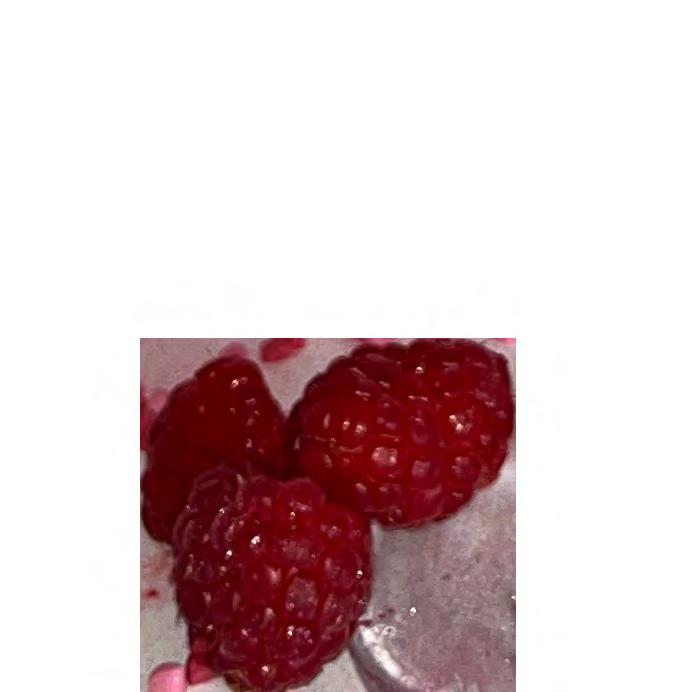
Four strawberries
Two shots of raspberry Sourz
Pink raspberry Hooch
Rosé
Edible glitter
Sprinkles
